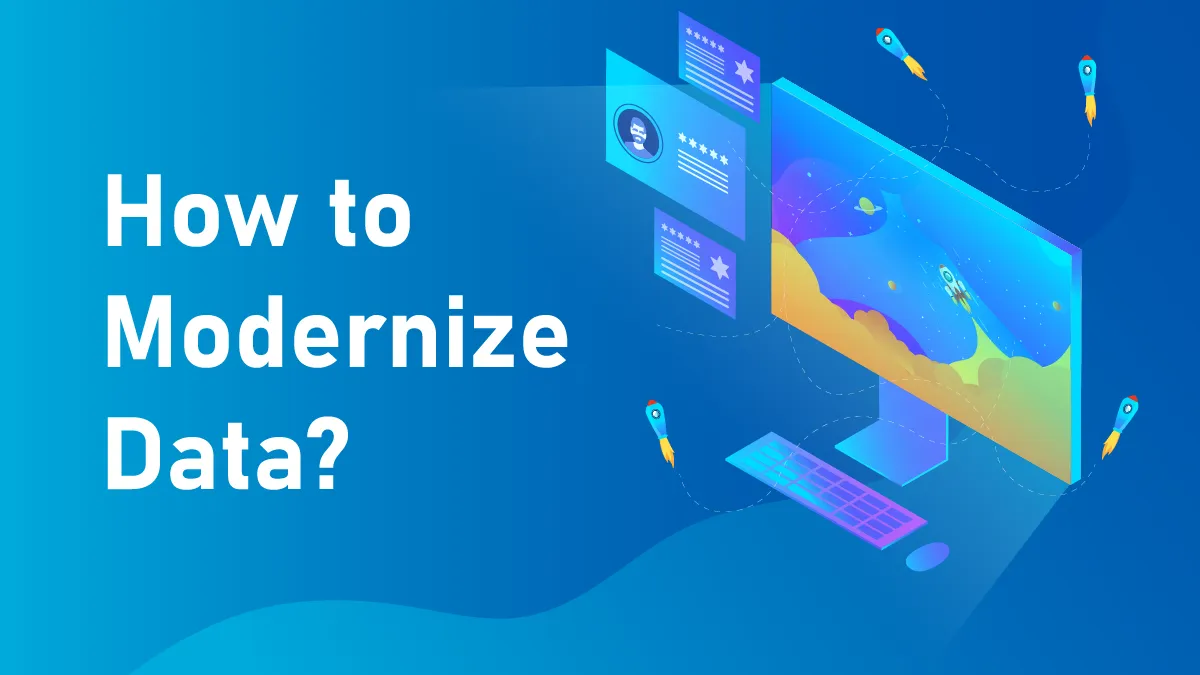Data is omnipresent in today’s data-driven world, making data modernization essential for companies to stay competitive. It helps businesses make informed decisions and use their data. Also, it uses machine learning, analytics, and AI. This lets firms quickly recognize and seize opportunities.
Data modernization is examined in this article along with its advantages, significance, and effective modernization strategy.
Let’s dig in!
What is Data Modernization?
Data modernization is the process of converting and optimizing vast amounts of collected data into a more valuable, accessible, and usable format in order to provide insightful findings and business outcomes. It entails using modern technology to fix outdated data management methods.
Simply put, making the switch to systems that allow for real-time data access and analysis is part of modernizing data infrastructure. Using cloud-based data warehouses, in-memory databases, and data streaming platforms—all of which make data consumption, processing, and retrieval easier—is part of the shift.
Benefits of Data Modernization
 Modernizing data comes with substantial benefits. It can help businesses stay competitive, boost productivity, and spur growth.
Modernizing data comes with substantial benefits. It can help businesses stay competitive, boost productivity, and spur growth.
● Better Decision-making
Modern data systems enable quicker, better-informed decision-making by providing timely and reliable information. Access to real-time data facilitates data democratization, which encourages collaboration and innovation.
● Increased Efficacy in Operations
Data modernization eliminates silos and reduces manual work. It does this by integrating and consolidating data from multiple sources. This leads to faster, more efficient processing. It further cuts operating expenses.
● Improved Customer Experience (CX)
Centrally stored customer data enables targeted marketing and personalized experiences. Modernizing data boosts customer satisfaction. It helps businesses offer timely, relevant products.
● Regulatory compliance
Improved data accuracy, integrity, security, and traceability are offered by modern data systems. These enhancements assist businesses in keeping audit trails and efficiently handling regulatory demands.
Also Read: Spatial Analysis Explained: Top 8 Tools for Effective Data Insights
Data Modernization: Key Components
A number of essential elements are involved in the process of modernizing data, all of which are necessary to enhance data systems.
● Data Integration
Data integration combines data from multiple sources into one system. This gives a complete view of the organization’s information for analysis and decision-making.
● Data Cleansing & Quality
Processes for data quality and cleansing eliminate errors and discrepancies in data. Reliable, clean data leads to improved analyses and insights. They result in better judgments and fewer mistakes.
● Data Consolidation
Data consolidation is combining information from multiple systems into one place. This centralized repository, or single source of truth (SSOT), provides a simplified data architecture. It further improves data accessibility, analysis, and use.
● Data Transformation
Data transformation changes information into a usable format for reporting and analysis. It brings data into compliance with the demands of contemporary applications and data systems. Proper transformation enables compatibility with advanced analytics tools. It allows interaction with other data sources and useful analysis.
● Data Migration
Data migration transfers information from outdated systems to modern ones. It’s a crucial stage in modernization. It ensures that important data is kept and available in new systems.
How to Modernize Data?
 Modernizing your data can be done in a variety of ways. Your business needs will determine your data modernization strategy. To maximize your efforts at modernizing data, you should, for the most part, follow these procedures.
Modernizing your data can be done in a variety of ways. Your business needs will determine your data modernization strategy. To maximize your efforts at modernizing data, you should, for the most part, follow these procedures.
Combine information from several sources into a single database.
Within a firm, data is often dispersed throughout multiple systems and applications. A consolidated database is a smart option. It keeps data current, accessible, and easy to find. Companies can build a database to access and examine their many data sets. It must connect to several data sources. This can provide fresh insights.
Create a map of your data assets
A key first step in any data modernization strategy is to find your organization’s data assets. To modernize data, you must choose the best approach. To do this, know the types of data that each department holds, where it is on the network, and its age and format.
Invest in artificial intelligence and machine learning
AI and machine learning can greatly aid in modernizing data. The most crucial uses of AI/ML for data are predictive analytics, process automation, and automated unstructured data extraction.
Secure your data
Moving data around and making it accessible to new users and apps are common steps in modernizing data. Use encrypted connections to keep your data safe on open networks, like WiFi and cellular networks. Encryption jumbles a message or file’s contents. This prevents unwanted parties from accessing private company information. It also makes the data unreadable without permission.
Test for sensitive information
Sensitive information is anything that may violate privacy, intellectual property, or commercial ethics laws. Sensitive data includes intellectual property, financial and health records, and PII. No matter how you upgrade and transfer your data, you must identify and test sensitive information. This will ensure compliance with industry standards and laws like HIPAA and GDPR.
Establish a governance plan
It’s easy to focus on other tasks and ignore regulatory needs during data modernization. For this reason, having a governance framework in place is crucial. A governance strategy, besides setting data usage rules, defines data ownership, management, and access. With a solid governance plan and the right staff, your data is more likely to stay safe and compliant while you update it. Put strong data security procedures in place to safeguard private data.
Cleanse your data
Cleaning up data is one way to modernize it. This means removing values that are redundant, invalid, or inaccurate. It will leave only accurate, relevant data in the existing fields. Prior to major data transfers, it’s also crucial to go through the data cleansing procedure.
Archive data
Data archives frequently keep earlier file versions and offer long-term digital information archiving. Data copies can be dispersed to several locations for backup purposes after an archive has been established. Companies that are not careful during modernization risk losing data. So, it’s critical to have backup plans and data archives.
Data Modernization Examples
There are numerous variations of data modernization, each suited to particular business requirements.
● Cloud Migration
Migrating apps and data from on-premises infrastructure to the cloud speeds up data processing, improves scalability, and lowers costs.
● Data Lake Implementation
Data accessibility is enhanced, advanced analytics are made possible, and data-driven decision-making is supported by the establishment of a common repository for both structured and unstructured data.
● Real-Time Data Processing
Real-time data pipelines, as opposed to batch processing, provide instant insights, increase operational effectiveness, and facilitate quicker reaction to market developments.
10 Proven Approaches to Build an Effective Data Modernization Strategy
The following are important recommended practices to remember:
1. Establish specific goals
Clearly state your aims and objectives when it comes to modernizing your data. Recognize the precise business issues you hope to resolve and the results you hope to attain. This clarity will aid in directing your implementation plan.
2. Put data governance in place
To ensure data security, compliance, and quality, implement strong data governance. Establish data standards, define data ownership, and implement data policies and processes. The basis for efficient data management during the modernization process is data governance.
3. Pay attention to data quality
When modernizing data, give priority to enhancing data quality. To improve data quality, invest in cleansing, validating, and standardizing it. Reliable decision-making and significant insights depend on high-quality data.
4. Use an agile approach
For your data modernization project, use agile principles. Divide the project up into smaller, more doable tasks and phases. To adjust and iterate as necessary, embrace adaptability, teamwork, and frequent feedback. Agile methods increase productivity and lower the risks involved in significant changes.
5. Make privacy and data security plans
Include strong privacy and security safeguards in your data transformation project. Make sure that data masking, access controls, and encryption are used to protect sensitive information. Adhere to applicable data protection laws and set up procedures for consent and data privacy.
6. Encourage data collaboration
Encourage cross-functional teamwork and collaboration during the data modernization process. Engage stakeholders from various departments. Ensure their opinions are heard and their needs met. Working together helps the organization develop a data-driven culture and a common understanding of data.
7. Adopt cloud-based and scalable solutions
For data processing, analytics, and storage, consider implementing cloud-based and scalable technologies. Cloud platforms provide cost-effectiveness, scalability, and flexibility. Use modern data processing and storage technologies. They will manage growing data and enable advanced analytics. Take into account analytics tools, cloud platforms, data warehouses, and data lakes, which offer automation, analysis, visualization, and data storage.
8. Make training and data literacy investments
You may promote data literacy in your company. Do this by offering training on data principles, tools, and best practices. Ascertain that teams possess the abilities needed to evaluate and comprehend data in an efficient manner. Employees are now empowered to use data insights and make decisions based on data.
9. Track and evaluate results
To measure your data modernization project’s success, set up metrics and KPIs. Keep a close eye on your efforts and evaluate their results in relation to your goals. Make use of the knowledge acquired to hone your strategy and keep your data modernization procedures getting better.
10. Look for external expertise
Consider hiring external consultants or partners with expertise in modernizing data. Their knowledge may help you overcome obstacles. It may also quicken your modernization journey. They can offer advice, direction, and support.
Concluding Thoughts
Data modernization controls the migration process. It requires knowing what data businesses have and organizing it. Then, decide what to migrate and what to leave out. Businesses must move, unpack, and reorganize the data in its new location. This will communicate its new location to all relevant parties. Organizations may position themselves to secure their data, run more effectively, and innovate in a cutthroat market by modernizing their data infrastructure. Whether it’s transitioning to cloud platforms, leveraging real-time analytics, or implementing advanced AI tools, the journey of modernizing data empowers businesses to not only stay competitive but also thrive in an ever-evolving digital landscape.

































